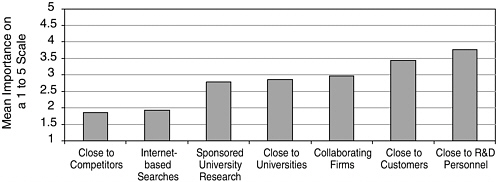R&D Location Strategies
The primary objective of the survey was to identify and rank the importance of factors that drive firm decisions on the location of R&D facilities. Questions regarding location decisions began with general questions about the importance of various drivers for the location of R&D. These questions did not refer to the location of particular facilities. Specifically, respondents were asked
Strategically, how important are each of the following drivers for the geographical location of your firm’s R&D? Use a scale of 1 to 5 where 5 is very important and 1 is not important at all.
The following seven statements were presented (shorthand notation for each is given in parentheses):
-
Sponsored research at universities or research institutes. (SponUniv)
-
Research collaborations with other firms. (CollabFirm)
-
Internet based searches for solutions to technical problems.1 (Internet)

FIGURE 4 Drivers of R&D location strategy.
-
Locating close to universities. (CloseUniv)
-
Locating close to highly qualified R&D personnel. (CloseR&D)
-
Locating close to competitors. (CloseComp)
-
Locating close to customers. (CloseCust)
The only statistically significant difference between U.S. and Western European firms (5-percent level) is in the importance of locating close to universities. Western European firms rate this as more important than do U.S. firms, though the mean scores are close (2.99 versus 2.65).
Because the importance of these factors does not vary significantly across regions (with the exception noted above), all regions are combined (including those outside the United States and Western Europe) in Figure 4. In tests for significant differences (1-percent level), there are four groupings: (1) Least important are Internet searches and locating close to competitors; these are not significantly different. (2) Research collaborations— whether through sponsored research, collaborations with other firms, or being close to universities—are next in importance. These are not significantly different from one another. (3) Locating close to customers is next in importance and significantly different from all other drivers. (4) Finally, of greatest importance—and significantly different from all other drivers—is being close to highly qualified R&D personnel.


